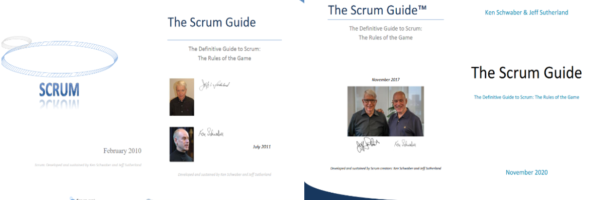The Scrum Guide – 2020
We developed Scrum in the early 1990s. We wrote the first version of the Scrum Guide in 2010 to help people worldwide understand Scrum. We have evolved the Guide since then through small, functional updates. Together, we stand behind it.
The Scrum Guide contains the definition of Scrum. Each element of the framework serves a specific purpose that is essential to the overall value and results realized with Scrum. Changing the core design or ideas of Scrum, leaving out elements, or not following the rules of Scrum, covers up problems and limits the benefits of Scrum, potentially even rendering it useless.
We follow the growing use of Scrum within an ever-growing complex world. We are humbled to see Scrum being adopted in many domains holding essentially complex work, beyond software product development where Scrum has its roots. As Scrum’s use spreads, developers, researchers, analysts, scientists, and other specialists do the work. We use the word “developers” in Scrum not to exclude, but to simplify. If you get value from Scrum, consider yourself included.
As Scrum is being used, patterns, processes, and insights that fit the Scrum framework as described in this document, may be found, applied and devised. Their description is beyond the purpose of the Scrum Guide because they are context sensitive and differ widely between Scrum uses. Such tactics for using within the Scrum framework vary widely and are described elsewhere.
©2017 Ken Schwaber and Jeff Sutherland. Offered for license under the Attribution Share-Alike license of Creative Commons, accessible at http://creativecommons.org/licenses/by-sa/4.0/legalcode and also described in summary form at http://creativecommons.org/licenses/by-sa/4.0/. By utilizing this Scrum Guide, you acknowledge and agree that you have read and agree to be bound by the terms of the Attribution Share-Alike license of Creative Commons.
Commentary
Despite this chapter looking like a foreword only, the ‘Purpose of the Scrum Guide’ has some interesting facts worth noticing. What is more, even PSM test questions target them, therefore it is a good idea to spend some minutes analyzing these statements.
Since the purpose of the Scrum Guide is to define Scrum, it is as high-level and abstract as possible. Its only goal is to describe the basic elements and rules binding them together. As stated, the tools, techniques, tactics and practices are context-sensitive and there are endless ways to apply them efficiently. The guide only focuses on the definition. Moreover, the Guide does not define how to integrate Scrum into the life of an organization. Ken Schwaber gave invaluable insight into these characteristics of Scrum in an interview at InfoQ: https://www.infoq.com/news/2010/08/kenschwaber-interview-part1/.
The Guide states multiple times that Scrum is a framework. In their books and articles, Schwaber and Sutherland often emphasize that:
- Scrum is not a definitive method. As a framework, it is intentionally incomplete, leaving the details for the practitioners.
- It is not a ‘cookbook’ but a coherent system, therefore, its elements are not arbitrary. The Guide underlines this in the End Note chapter.
Schwaber and Sutherland often use the adjective complex when they talk about the products delivered by Scrum. There are multiple reasons why it is important:
- Scrum slices large bodies of work into small, easy-to-manage pieces. This does not reduce the complexity of the product but the body of work to be done at a time.
- Scrum is best suited for cross-functional teams. Cross-functional teams by nature usually work on complex problems.
- In the early times of Agile, people often questioned whether Scrum was capable of dealing with complex systems and projects. The concept of a cross-functional team and the lack of comprehensive upfront planning was new and odd to IT professionals. By now, Scrum has proven itself, this doubt is history.
Key Takeaways
- Scrum is a framework.
- ‘Developer’ does not mean software developer.
- Scrum is not only for software development.
Some of these statements are further detailed in the next chapter (Scrum Definition).
The Scrum Guide – 2017
Purpose of the Scrum Guide
Scrum is a framework for developing, delivering, and sustaining complex products. This Guide contains the definition of Scrum. This definition consists of Scrum’s roles, events, artifacts, and the rules that bind them together. Ken Schwaber and Jeff Sutherland developed Scrum; the Scrum Guide is written and provided by them. Together, they stand behind the Scrum Guide.
©2017 Ken Schwaber and Jeff Sutherland.
The Scrum Guide – 2010
Purpose
Scrum has been used to develop complex products since the early 1990s. This paper describes how to use Scrum to build products. Scrum is not a process or a technique for building products; rather, it is a framework within which you can employ various processes and techniques. The role of Scrum is to surface the relative efficacy of your development practices so that you can improve upon them while providing a framework within which complex products can be developed.
© 2008-2010 Ken Schwaber and Jeff Sutherland, All Rights Reserved
